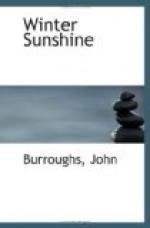But all the excellences of the apple are not confined to the cultivated fruit. Occasionally a seedling springs up about the farm that produces fruit of rare beauty and worth. In sections peculiarly adapted to the apple, like a certain belt along the Hudson River, I have noticed that most of the wild, unbidden trees bear good, edible fruit. In cold and ungenial districts the seedlings are mostly sour and crabbed, but in more favorable soils they are oftener mild and sweet. I know wild apples that ripen in August, and that do not need, if it could be had, Thoreau’s sauce of sharp, November air to be eaten with. At the foot of a hill near me, and striking its roots deep in the shale, is a giant specimen of native tree that bears an apple that has about the clearest, waxiest, most transparent complexion I ever saw. It is of good size, and the color of a tea rose. Its quality is best appreciated in the kitchen. I know another seedling of excellent quality, and so remarkable for its firmness and density that it is known on the farm where it grows as the “heavy apple.”
I have alluded to Thoreau, to whom all lovers of the apple and its tree are under obligation. His chapter on Wild Apples is a most delicious piece of writing. It has a “tang and smack” like the fruit it celebrates, and is dashed and streaked with color in the same manner. It has the hue and perfume of the crab, and the richness and raciness of the pippin. But Thoreau loved other apples than the wild sorts, and was obliged to confess that his favorites could not be eaten indoors. Late in November he found a blue-pearmain tree growing within the edge of a swamp, almost as good as wild. “You would not suppose,” he says, “that there was any fruit left there on the first survey, but you must look according to system. Those which lie exposed are quite brown and rotten now, or perchance a few still show one blooming cheek here and there amid the wet leaves. Nevertheless, with experienced eyes I explore amid the bare alders, and the huckleberry bushes, and the withered sedge, and in the crevices of the rocks, which are full of leaves, and pry under the fallen and decaying ferns which, with apple and alder leaves, thickly strew the ground. For I know that they lie concealed, fallen into hollows long since, and covered up by the leaves of the tree itself,—a proper kind of packing. From these lurkingplaces, anywhere within the circumference of the tree, I draw forth the fruit all wet and glossy, maybe nibbled by rabbits and hollowed out by crickets, and perhaps with a leaf or two cemented to it (as Curzon an old manuscript from a monastery’s mouldy cellar), but still with a rich bloom on it, and at least as ripe and well kept, if not better than those in barrels, more crisp and lively than they. If these resources fail to yield anything, I have learned to look between the bases of the suckers which spring thickly from some horizontal limb, for now and then one lodges there, or in the very midst of an alderclump, where they are covered by leaves, safe from cows which may have smelled them out. If I am sharp-set,—for I do not refuse the blue-pearmain,—I fill my pockets on each side; and as I retrace my steps in the frosty eve, being perhaps four or five miles from home, I eat one first from this side, and then from that, to keep my balance.”




